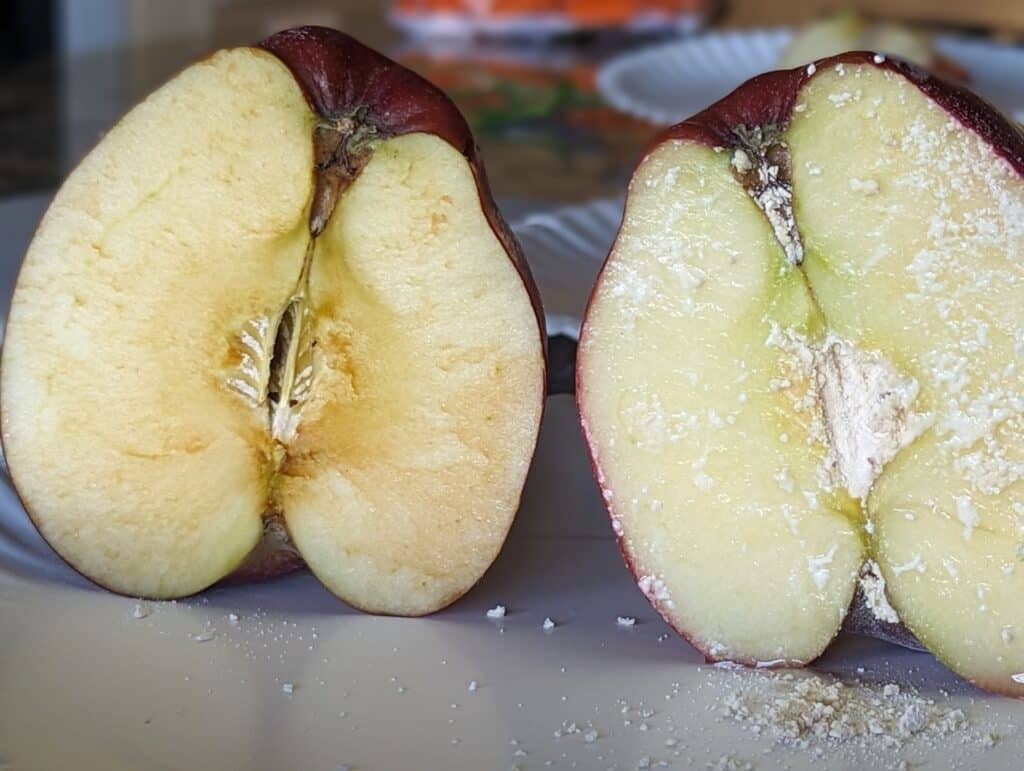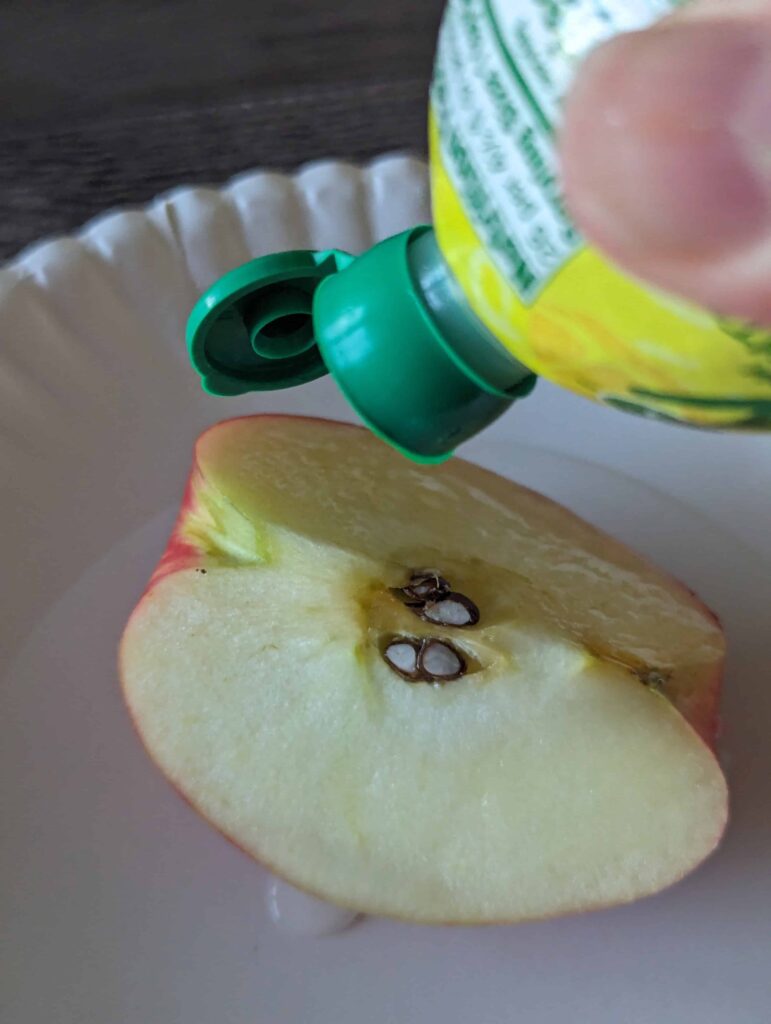Vitamin C And Apple Experiment
Last week in the Lab Report, we saw enzymes in action. Today, I want to show you an apple experiment that will allow you to see enzymes in action and show you how to prevent the same enzyme activity.
This Vitamin C and apple experiment post includes a free printable. This can be used with multiple grades, including middle and high school. However, we have included pages for younger students too.
Apples contain an enzyme called polyphenol oxidase (phenolase). When an apple is cut, the enzymes inside are released. Oxygen from the air causes phenolase to catalyse (speed up the process) the formation of brown pigments called melanins. This is called oxidation or enzymatic browning. It’s kind of like rust forming on metal – another form of oxidation.
More specifically, oxidation is a chemical reaction that involves the loss of electrons by a substance. (In this experiment, the substance is the apple.) During oxidation, a compound or molecule loses electrons, which causes it to become more positively charged. This process often involves the addition of oxygen or the removal of hydrogen atoms from the substance.
I’m sure you have seen this process occur. Just think what happens to cut apples and bananas when left out on a counter for a while. They turn brown and unappealing.
Certain substances can stop or slow down this process. Today we are going to use Vitamin C because of its antioxidant properties. Anti- means against in Greek and oxidation means to “combine with oxygen”. The ascorbic acid in the Vitamin C tables act as an antioxidant. So, antioxidants help prevent the damage done to foods or our bodies due to exposure to oxygen.
How exactly does the ascorbic acid prevent browning? To be specific, the Vitamin C donates electrons to the apple in our experiment which inhibits the polyphenol oxidase enzymes in the apple.
Let’s test this. For today’s experiment, you will need one apple cut in half and 10 vitamin C tablets.
First, crush the Vitamin C tablets. We put them on a paper plate and used a rolling pin to pulverize them.

Sprinkle one half of a cut apple with the crushed Citamin C tablets.
Set the two apples halves – one with the Vitamin C and one without- side by side. Observe them over time. What do you see? Keep track of each apple every 15 minutes for the next hour or two. What is happening to the apples? Are they different or the same?
Use the worksheets we created to use with the Vitamin C and apple experiment to record your observations. Use the request form at the end of the post to get your free copy.
What you should observe is browning occuring in the apple without the vitamin C within the first 30 minutes, while the apple with the vitamin C should remain unchanged at first. You may see overtime the vitamin C apple will start to brown a bit. The ascorbic acid in the vitamin C tablet doesn’t stop the enzymes from reacting. Instead, the oxygen reacts with the ascorbic acid before the enzymes, therefore stalling the enzymatic browning. However, once all the ascorbic acid reacts with the oxygen, the oxygen will then react with the enzymes and cause the browning of the apple.
Testing Apples with Other Substances
Let’s take our Vitamin C and apple experiment one step further by testing other substances, along with the vitamin c tablets with lemon juice, orange juice, and vinegar.
Will any of these substances prevent or stall the enzymatic browning?
Here is a little background research your students can do:
- What types of acid does lemon juice contain?
- What types of acid does orange juice contain?
- What type of acid does vinegar contain?
You may want to use the printable that we have created to complete the following experiment.
First, gather another apple, a knife, 4 plates, vinegar, lemon juice, and fresh or bottle orange juice, crushed vitamin C tables (about 3) marker, knife
- Cut the apple into quarters.
- Place one quarter piece on each paper plate and label the paper plates – one each with “lemon juice”, “orange juice”, “vinegar”, “crushed tablets”
- Place one quarter piece of apple on the lemon juice dish and put lemon juice on the entire cut side. You’ll need a few tablespoons of lemon juice.
- Place one quarter piece on the vinegar plate and put vinegar on the entire cut side. You’ll eed a few tablespoons of vinegar.
- Place one quarter piece on the orange juice plate and put oj on the entire cut side.
- Place the last quarter piece on its plate and cover it with crushed vitamin c tablet.
- Note the time and then check the apples every 15 minutes or so.
Procedure:
- Cut the apple into quarters.
- Place one quarter piece on each paper plate and label the paper plates – one each with “lemon juice”, “orange juice”, “vinegar”, “crushed tablets”
- Place one quarter piece of apple on the lemon juice dish and put lemon juice on the entire cut side. You’ll need a few tablespoons of lemon juice.
- Place one quarter piece on the vinegar plate and put vinegar on the entire cut side. You’ll eed a few tablespoons of vinegar.
- Place one quarter piece on the orange juice plate and put oj on the entire cut side.
- Place the last quarter piece on its plate and cover it with crushed vitamin c tablet.
- Note the time and then check the apples every 15 minutes or so.
How are these quarter slices doing compared to the untreated apple half in the first half of our apple and vitamin c experiment?
Which apple started to show some slight yellowing? Our vinegar apple started to show a yellowish-brown outline first (below left), after about 30 minutes. The orange juice slice was the next sample that started to show some yellowing (below right).
Bonus Apple Science Activity – Applesauce Oobleck!
Add to the apple fun by making applesauce oobleck! You can either make homemade applesauce with the apples you have on hand or purchase some unsweetened applesauce.
Gather cornstarch, the applesauce, and cinnamon. The cinnamon is optional, but it adds a nice scent to the activity!
Procedure:
- Measure out 2 cups of cornstarch
- Measure out 1 cup of unsweetened applesauce
- Mix the conrstarch and applesauce in a large bowl
- Sprinkle in some cinnamon
- Mix well. If the oobleck is too dry, add more applesauce. If the oobleck is too wet, add more cornstarch.
Request the Apple and Vitamin C Experiment Worksheets
Other Resources
We have some life cycle of an apple tree pages to the free printable. Here is a video demonstrating how to grow apple trees and has some time lapse footage.
Check out our other fruit science activihttps://www.chemicalsafetyfacts.org/chemicals/ascorbic-acid/ties:
- 6 Experiments with Oranges, includes a free printable
- Extracting DNA from strawberries, includes a free printable
- For middle and high school students – information on how ascorbic acid as a chemical preservative in foods and other products. Information from chemicalsafetyfacts.org.
I hold a master’s degree in child development and early education and am working on a post-baccalaureate in biology. I spent 15 years working for a biotechnology company developing IT systems in DNA testing laboratories across the US. I taught K4 in a private school, homeschooled my children, and have taught on the mission field in southern Asia. For 4 years, I served on our state’s FIRST Lego League tournament Board and served as the Judging Director. I own thehomeschoolscientist and also write a regular science column for Homeschooling Today Magazine. You’ll also find my writings on the CTCMath blog. Through this site, I have authored over 50 math and science resources.














